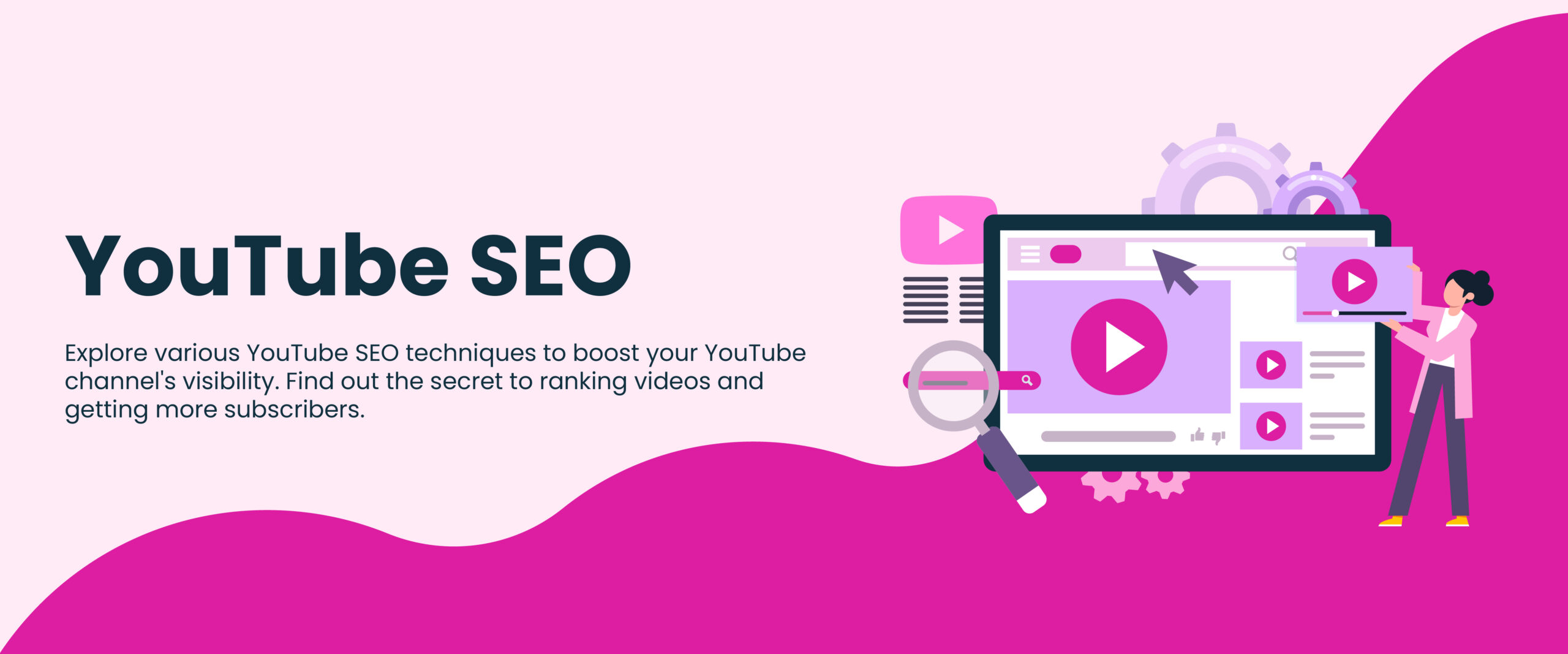Guide to YouTube SEO: How to Boost Your Video Rankings & Reach
Did you know that content creators can boost their visibility and reach on YouTube by utilizing essential YouTube SEO techniques? Creators may improve their chances of appearing in pertinent search results, drawing more viewers, and ultimately expanding their channel by optimizing their videos for search engines. In this blog, we will explore the essential strategies and techniques to enhance your YouTube SEO.
What is SEO on YouTube?
YouTube SEO refers to the process of optimizing video content and channels on YouTube to improve their visibility and reach. It involves strategic practices, such as keyword research, optimizing titles, descriptions, and tags, as well as utilizing engaging thumbnails, and promoting videos through social media.
To enhance visibility on YouTube, optimize your video content and channel using SEO techniques, include relevant keywords in titles and descriptions, create enticing content, use tags and categories effectively, and promote videos on social media. Applying these techniques expands your audience, boosting viewership and subscribers. If you want to learn about building a presence on YouTube, consider taking an online digital marketing course.
Benefits of Optimizing YouTube Videos for Search Engines
Optimizing YouTube videos for search engines has several benefits, some of which are:
- It enables your content to be easily discovered by potential readers who are actively seeking similar content.
- This, in turn, leads to increased viewer engagement and a longer duration of their viewership on your videos.
- It enhances your search engine rankings, resulting in greater exposure and organic traffic.
- Ultimately, it also enhances the growth and revenue potential of your channel.
By optimizing your videos for search engines, you can expand your audience, attract more viewers, and enhance the popularity and revenue of your YouTube channel.
YouTube Keyword Research
Conducting keyword research is a vital step in enhancing the performance of your YouTube channel. It entails identifying suitable and popular keywords that correspond with the content of your videos.
- It is important to take some time to brainstorm ideas and keywords that are relevant to your specific area of focus.
- To accomplish this, make use of various keyword research tools, such as Google Trends, YouTube Autocomplete, and VidIQ.
- These tools can help you discover highly searched queries and current trends within your niche.
For example, if you have a cooking channel and want to create a video on “healthy smoothie recipes”, conduct keyword research on variations and related keywords like “nutritious smoothies”, “smoothie ingredients”, or “easy smoothie recipes”. By conducting thorough keyword research, YouTubers can optimize their video content to match popular search queries. This helps increase visibility and attract relevant viewers to their channel.


Optimizing Video Titles and Descriptions
By optimizing video titles and descriptions, businesses can enhance the discoverability and appeal of their videos, improving their chances of attracting viewers and boosting engagement with their content. Here’s how you can do it.
1. Optimizing Video Titles
You can optimize your video titles in the following ways:
- Incorporate target keywords naturally within titles to improve relevance and visibility.
- Aim for concise and attention-grabbing titles that accurately represent the video content.
- Use keyword-rich titles instead of generic ones to attract viewers and search engines.
For example, instead of “Smoothie Recipes”, use “7 Delicious and Nutritious Smoothie Recipes for a Healthy Lifestyle”. These steps will help your video reach a broader audience.
2. Optimizing Video Descriptions
You can optimize your video descriptions in the following ways:
- Provide a comprehensive overview of the video’s content, including relevant keywords, timestamps, and additional information.
- Include calls-to-action (CTAs) to encourage viewer engagement, such as subscribing, liking, or visiting your website.
Video Tags and Categories
Tags and categories play a significant role in YouTube’s understanding of your video’s content and its ability to recommend it to relevant audiences. Here’s how you can optimize their usage:
1. Tags
Consider the following points:
- Select specific and general tags that accurately represent your video.
- Use a combination of broader tags (e.g., “smoothie recipes”) and more specific tags (e.g., “vegan smoothies,” “quick breakfast ideas”).
2. Categories
Consider the following points:
- Choose the most relevant category for your video, aligning it with the primary topic or theme.
- This helps YouTube’s algorithm categorize and recommend your video to interested viewers.
By strategically utilizing tags and selecting appropriate categories, you can enhance YouTube’s understanding of your video’s content and increase its visibility among relevant audiences.
Explore the best digital marketing course with placement guarantee to excel in all the concepts of digital marketing.
Thumbnails and Visual Appeal
Eye-catching thumbnails are vital for increasing click-through rates and enticing viewers to click on your videos.
- Create visually appealing and high-quality thumbnails that accurately represent your video content.
- Use contrasting colors, compelling images, and legible text to make your thumbnail stand out.
For example, if your video showcases a vibrant green smoothie, a thumbnail featuring the colorful smoothie, along with a text overlay, can catch viewers’ attention. Remember to optimize thumbnail sizes to ensure they appear clear and appealing on different devices. YouTube recommends a resolution of 1280 x 720 pixels and an aspect ratio of 16:9 for thumbnails.
Video Transcriptions and Closed Captions
Providing accurate video transcriptions and closed captions offers several benefits. These benefits include:
- Improve accessibility for viewers with hearing impairments or those watching videos in a noise-sensitive environment.
- Contribute to YouTube SEO by enabling search engines to understand the context and content of your video.
Steps to Add Transcriptions and Closed Captions
To add transcriptions and closed captions to your videos, you can do the following:
- Utilize YouTube’s built-in transcription features.
- Upload external caption files.
- Review and edit the generated transcriptions to ensure accuracy and correct any errors.
By incorporating transcriptions and closed captions into your videos, you enhance accessibility and reach a wider audience.
Engagement Signals and Metrics
When engaging with signals and metrics, consider these key points:
- Engagement signals like watch time, likes, comments, and shares are vital for ranking videos higher in search results and recommendations.
- Creating valuable and engaging content is essential to increasing viewer engagement.
- Encourage viewers to like, comment, and share your videos by explicitly asking for their participation during the video or in the description.
- Foster a sense of community and interaction by responding promptly to comments.
By focusing on increasing viewer engagement through valuable content, active audience participation, and fostering a sense of community, content creators can improve their YouTube SEO and enhance the overall visibility and reach of their videos.
Promoting Videos on YouTube and Beyond
Promotion plays a significant role in expanding your video’s reach beyond YouTube’s platform. Leverage social media platforms to share your videos, collaborate with other creators in your niche, and cross-promote each other’s content.
Embed your videos on your website or blog, and encourage external websites to link to your videos. This improves your video’s authority and searchability.
YouTube Algorithm and Updates
Understanding the YouTube algorithm is crucial for optimizing your videos effectively. The algorithm considers various factors, including watch time, viewer retention, engagement, and relevance, to determine video rankings.
Stay updated with the latest algorithm changes by following YouTube’s official announcements, industry news, and reputable SEO resources. Adapt your strategies accordingly to align with algorithm updates and maximize your video’s visibility.
Additional YouTube SEO Tips and Best Practices
To further enhance your SEO on YouTube, use the following tips:
- Optimize Video Length: Aim for an optimal video length based on your target audience and content type. Keep your videos concise, engaging, and packed with valuable information.
- Focus on Audience Retention: Create compelling intros, use storytelling techniques, and maintain viewer interest throughout your videos to improve audience retention rates.
- Ensure Video Quality: Invest in good equipment, lighting, and audio to deliver high-quality videos that captivate your viewers.
- Branding and Consistency: Establish a consistent brand identity through your channel art, intros, and outros. Maintain a consistent upload schedule to keep your audience engaged and coming back for more.
- Foster Audience Interaction: Encourage viewers to subscribe, like, and comment on your videos. Respond to comments and engage with your audience to build a loyal community.
Conclusion
Mastering YouTube SEO is essential for content creators looking to maximize their video’s reach and engagement on the platform. By understanding the importance of keyword research, optimizing titles, descriptions, tags, and thumbnails, and leveraging engagement signals, you can achieve the full potential of your video content.







